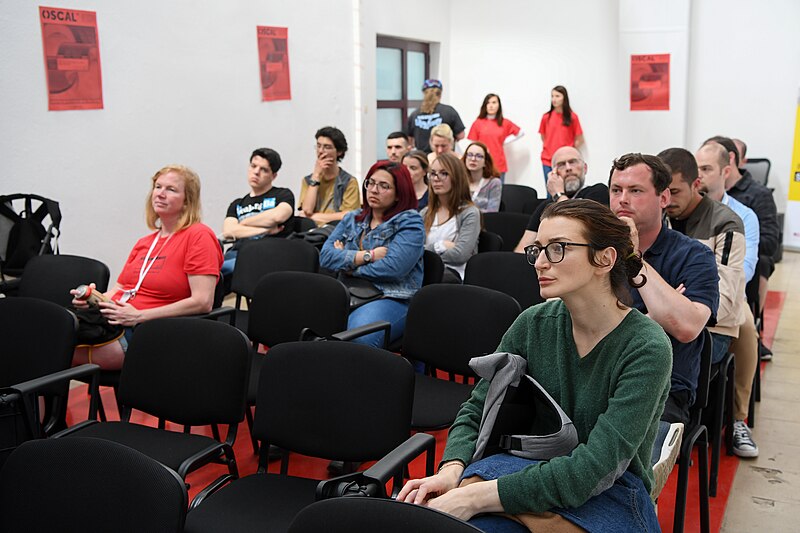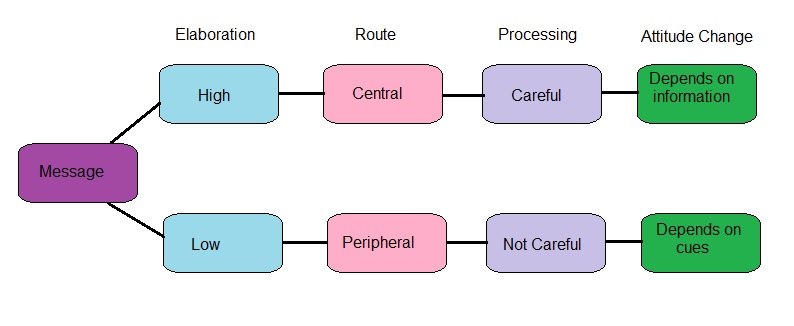Communication-Specific Persuasion Theories
 While many theories surrounding effective persuasion exist, several of them apply specifically to the field of communication studies. This chapter will conclude by discussing two of those theories: the Elaboration Likelihood Model (Petty & Cacioppo, 1986) and Social Judgment Theory (Sherif, 1963).
While many theories surrounding effective persuasion exist, several of them apply specifically to the field of communication studies. This chapter will conclude by discussing two of those theories: the Elaboration Likelihood Model (Petty & Cacioppo, 1986) and Social Judgment Theory (Sherif, 1963).
Elaboration Likelihood Model
This theory, abbreviated as ELM, attempts to describe why certain methods of persuasion work, even though mysterious, and why others fail. Known as a dual-process model, ELM describes a central route to persuasion and a peripheral route to persuasion. According to communication theory expert, Em Griffin (2014) :
Message elaboration is the central route of persuasion that produces major positive attitude change. It occurs when unbiased listeners are motivated and able to scrutinize arguments that they consider strong. Message-irrelevant factors hold sway on the peripheral path, a more common route that produces fragile shifts in attitude.
In the central route, the persuader practices many of the techniques described in this chapter. For someone to utilize the central route, ELM suggests that audience members need motivation in order for persuasion to work. In other words, each person the speaker’s attempting to persuade must commit the mental energy required to listen to the persuasion process. ELM also suggests that, at the beginning of a persuasive interaction, listeners decide almost immediately if they will continue to listen or not. This showcases why the speaker’s initial persuasive communication remains of critical importance. The listener may find the central route cumbersome and difficult, as it requires 1) mental effort, 2) use of logic and rational support, and most often, 3) more time and commitment than the peripheral route. Its use can result in significantly larger attitude or behavior changes.
 In the peripheral route, the message recipient has little to no interest in the subject material, and as such, has no desire to commit the mental energy to go through the central processing route. If the listener takes the peripheral route, he or she will look for information that “feels right” and often make decisions solely based upon first impressions. In the peripheral route, listeners become swayed more by irrational appeal to emotion than logical and balanced messages. Advertisers frequently rely on the peripheral route, as most commercials last only 30–60 seconds. Celebrity endorsements or unrelated humor in commercials highlight examples of advertisers attempting to engage its audience using the peripheral route to persuasion. Consumers making purchases based on factors like these means that the persuasive message was effective, however these effects are often short-lived and vulnerable to outside influence, unlike the central route. For example, a person may purchase car insurance based on a funny advertisement, but will likely stop laughing when their first bill does not match the quoted price.
In the peripheral route, the message recipient has little to no interest in the subject material, and as such, has no desire to commit the mental energy to go through the central processing route. If the listener takes the peripheral route, he or she will look for information that “feels right” and often make decisions solely based upon first impressions. In the peripheral route, listeners become swayed more by irrational appeal to emotion than logical and balanced messages. Advertisers frequently rely on the peripheral route, as most commercials last only 30–60 seconds. Celebrity endorsements or unrelated humor in commercials highlight examples of advertisers attempting to engage its audience using the peripheral route to persuasion. Consumers making purchases based on factors like these means that the persuasive message was effective, however these effects are often short-lived and vulnerable to outside influence, unlike the central route. For example, a person may purchase car insurance based on a funny advertisement, but will likely stop laughing when their first bill does not match the quoted price.
Social Judgment Theory
This theory, developed by Muzafer Sherif, attempts to explain how people evaluate and rationalize various ideas and positions. According to SJT, every new idea individuals hear from a persuasive message gets weighted and evaluated against their current points of view before being placed on an attitude scale. SJT explains how people subconsciously sort out ideas as they occur at the instant they perceive them. Em Griffin (2014) explains SJT as follows:
The larger the discrepancy between a speaker’s position and a listener’s point of view, the greater the change in attitude—as long as the message is within the hearer’s latitude of acceptance. High ego-involvement usually indicates a wide latitude of rejection. Messages that fall there may have a boomerang effect.
As people assess the feasibility of new ideas, they place those ideas within one of three zones, or latitudes:
- The latitude of acceptance (agreement with the idea)
- The latitude of noncommitment (no opinion)
- The latitude of rejection (opposition to the idea)
When individuals have a high level of interest or involvement with the idea, their scale reduces to two, as the latitude of noncommitment shrinks with more rigidly held opinions. If the idea falls within the latitude of acceptance, they will adjust their attitude or behavior to match the idea, but if the idea falls inside their latitude of rejection, they will adjust themselves away from the idea.
Em Griffin (2014) suggested that persuaders wishing to achieve the greatest level of influence should choose a message on the edge of the audience’s latitude of acceptance or noncommitment.
Note to Self
Griffin also noted that persuasion often occurs at a slow and gradual process that most often consists of small movements.

